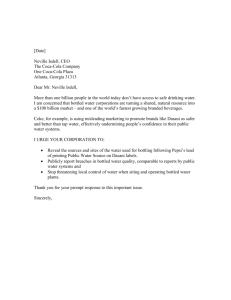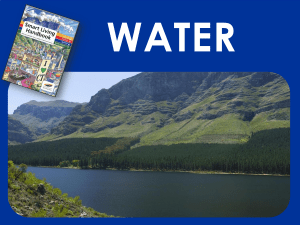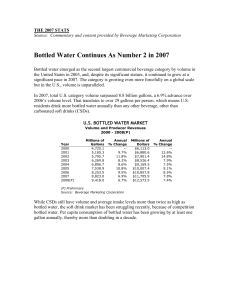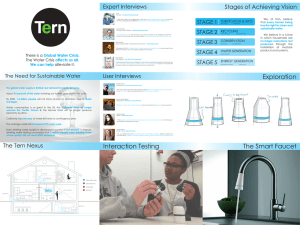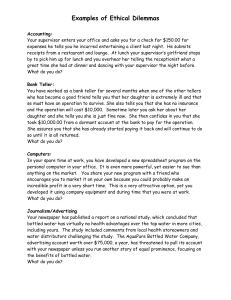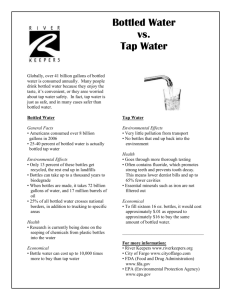B TTLED WATER 2011: THE RECOVERY CONTINUES
advertisement
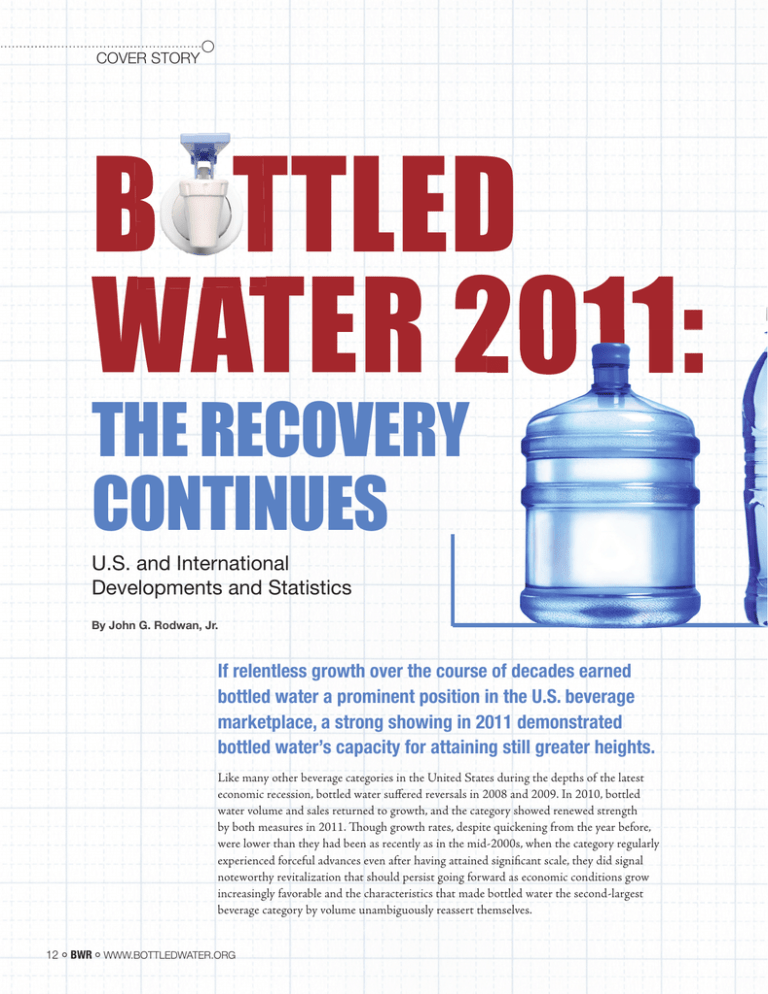
coVer story B TTLED WATER 2011: THE RECOVERY CONTINUES U.s. and international developments and statistics By John G. Rodwan, Jr. If relentless growth over the course of decades earned bottled water a prominent position in the U.S. beverage marketplace, a strong showing in 2011 demonstrated bottled water’s capacity for attaining still greater heights. Like many other beverage categories in the United States during the depths of the latest economic recession, bottled water suffered reversals in 2008 and 2009. In 2010, bottled water volume and sales returned to growth, and the category showed renewed strength by both measures in 2011. Though growth rates, despite quickening from the year before, were lower than they had been as recently as in the mid-2000s, when the category regularly experienced forceful advances even after having attained significant scale, they did signal noteworthy revitalization that should persist going forward as economic conditions grow increasingly favorable and the characteristics that made bottled water the second-largest beverage category by volume unambiguously reassert themselves. 12 BWR www.bottledwater.org Bottled water enjoyed a unique position within the overall liquid refreshment beverage marketplace, as the performance of other categories makes vividly evident. Though carbonated soft drinks remain by far the largest beverage type in the United States, their volume shrank again in 2011, as it did every year since the mid-2000s. Fruit beverages have similarly been beset with long-term erosion, withering from having volume comparable to bottled water in the late 1990s to having volume less than half the size by 2011. Like bottled water, other, feistier liquid refreshment beverages, such as ready-to-drink tea and sports beverages, rebounded from back-to-back off years to grow in 2010 and then accelerate in 2011, but they remained much, much smaller than bottled water. Although sports beverages like Gatorade may actively compete for consumers seeking hydration, their volume was about one-seventh that of bottled water in 2011. Before the economic challenges at the end of the decade, bottled water experienced an exceptional streak of speedy volume growth, as documented in the latest edition of Bottled Water in the U.S., Beverage Marketing Corporation’s annual analysis of the market. During the 2000s, bottled water volume achieved double-digit percentage growth rates in two years and advanced at rates close to that level in several others. Bottled water volume grew by close to 12 percent in 2002, and after growing by 10.8 percent in 2005, it enlarged by 9.5 percent in 2006. By contrast, carbonated soft drinks followed several years of slow growth with multiple volume reductions. In fact, the category suffered its seventh consecutive year of volume reduction in 2011. With bottled water, on the other hand, two consecutive declines were aberrations, mere blips, not the start of a protracted losing april/May 2012 BWR 13 Even so, average intake of beverages within bottled water’s competitive set, such as ready-to-drink tea and sports beverages, remained fractions of bottled water’s per capita consumption level. Indeed, bottled water added more gallons to its per-person consumption rate in 10 years than either ready-to-drink tea or sports beverages reached by the end of that period. In fact, neither even reached 5 gallons per U.S. consumer by 2011. Bottled water proved itself to be not only a key component of the liquid refreshment beverage market, it also proved itself to be poised for future increases in per capita consumption. streak. Departing from the pattern of preceding years, bottled water volume declined by 1.0 percent in 2008 and then by 2.5 percent in 2009. Furthermore, producers’ revenues declined in both 2008 and 2009 as well, and did so more precipitously. Bottled water wholesale dollar sales first exceeded $6 billion in 2000. By 2007, they topped $11.5 billion. Category sales declined by more than 3 percent to $11.2 billion the following year and then by more than 5 percent to less than $10.6 billion in 2009. Nevertheless, by 2010, bottled water had nearly recouped its losses with volume just 3.2 million gallons shy of the historical high hit in 2007. And by 2011, volume completely overcame its earlier setbacks, achieving an unprecedented high. While wholesale dollars still have some ways to go before matching the summit attained prior to 2008, they did inch upward in 2010 and approached $11.1 billion in 2011. U.S. BOTTLED WATER MARKET per capita consumption 2001 – 2011 All signs point to U.S. consumers’ already-displayed thirst for bottled water continuing in the years ahead. Changes in per capita consumption indicate persistent interest in a product that consumers embrace as a healthful alternative to other beverages. Americans upped their annual consumption by 11 gallons from 18.2 gallons per person in 2001 to 29.2 gallons 10 years later. During the same period, per capita consumption of carbonated soft drinks dropped by more than 9 gallons. Per capita consumption of other major beverage categories, like milk and fruit beverages, also declined. Other types, including coffee and tea, were characterized by stability, though the ready-to-drink versions of both categories made gains. Indeed, those beverages associated with beneficial properties and functional benefits—a subset that includes packaged water as well as energy drinks, sports beverages and ready-to-drink tea— were the most resilient products of the beverage market in 2010 and 2011. year gallons per capita annual % change 2001 18.2 -- 2002 20.1 10.6% 2003 21.6 7.2% 2004 23.2 7.5% 2005 25.4 9.7% 2006 27.6 8.4% 2007 29.0 5.3% 2008 28.5 -1.8% 2009 27.6 -3.2% 2010 28.3 2.6% 2011 29.2 3.2% source: beverage Marketing corporation copyright © 2012 by beverage Marketing corporation U.S. BOTTLED WATER MARKET volume and producer revenues 2009 – 2011 year Millions of gallons annual % change Millions of dollars annual % change 2009 8,453.1 -- $10,601.3 -- 2010 8,750.6 3.5% $10,683.8 0.8% 2011 9,107.3 4.1% $11,083.8 3.7% source: beverage Marketing corporation copyright © 2012 by beverage Marketing corporation 14 BWR www.bottledwater.org bottled water recovery 2011 Many factors account for U.S. consumers’ enthusiasm for bottled water, which include its association with healthfulness, safety, convenience, and value. Bottled water’s versatility makes it suitable for consumption at any time of day and in practically any circumstance. It doesn’t need to be kept cold (like soft drinks or juice) or warm (like conventional coffee or tea). As far as ready-to-drink commercial beverages go, it’s comparatively inexpensive, and, with competitive (sometimes aggressive) pricing, it is becoming increasingly affordable for consumers. Various packaging types, ranging from bulk to single-serve, facilitate a variety of uses. Consumers’ interest in foods and beverages that deliver benefits above and beyond refreshment also contributes to the quintessential hydrating beverage’s ascension in the beverage rankings. In the midst of pervasive worries about obesity and other health matters, bottled water’s lack of calories and artificial ingredients attracts conscientious consumers. Even where tap water may be safely potable, many people prefer bottled water, which they regard as superior in taste. The convenient availability of packaged water wherever beverages are sold also crucially differentiates bottled water from tap. Although bottled water has often been likened to tap water, bottled water actually achieved its market stature by enticing consumers away from other packaged beverages perceived as less wholesome than bottled water. While some consumers may have turned away from regular, fullcalorie sodas in favor of their diet versions, many others moved over to bottled water instead. Although bottled water has often been likened to tap water, bottled water actually achieved its market stature by enticing consumers away from other packaged beverages perceived as less wholesome than bottled water. Domestic non-sparkling water perennially reigns as the biggest segment of the U.S. packaged water industry. Domestic non-sparkling water’s 8.75 billion gallons represented 96 percent of total volume in 2011. As a whole, domestic non-sparkling saw slower volume reductions than the overall market in 2008 and 2009 and then outperformed it again in 2010 and 2011. first time since the mid-2000s, all four segments registered growth, albeit at very different rates. That marked a change from the year before, when only two segments grew. Throughout most of the 1990s and 2000s, the retail premium segment—consisting of still water in single-serve polyethylene terephthalate (PET) bottles—drove the overall category’s development. Indeed, the PET component enlarged by a double-digit percentage rate 16 consecutive times through 2007. Growth slowed markedly in 2008 before it disappeared in 2009. Yet PET’s 0.9 percent reduction was far less than the 2.5 percent loss measured for bottled water in general. Besides, the PET volume in 2009 of almost 5.2 billion gallons stood more than 4.1 billion gallons higher than it had in 1999, and its share of total bottled water swelled from 24 percent to more than 61 percent during that 10-year period. In 2010, PET experienced the strongest growth of any bottled water segment, advancing by 6.7 percent to 5.5 billion gallons, which boosted its share above 63 percent. Growth slowed in 2011 but remained well in advance of the total market: volume greater than 5.8 billion gallons flowed from growth of 5.4 percent, which pushed PET’s share to 64 percent. The non-sparkling category includes various components that typically follow divergent trajectories. In 2011, for the Retail bulk volume growth slowed as more and more consumers selected convenient PET multipacks in large for- Barriers to beverage market growth in the late 2000s appear to have lowered at the dawn of the new decade. Energy, commodity, and other input costs contributed to higher prices for consumers. That drove them to seek savings by opting for smaller, more affordable unit sizes, eschewing pricier imports, or occasionally foregoing packaged beverages altogether, which largely explains what happened in 2008 and 2009. The situation has now changed, and favorably so from bottled water marketers’ perspectives. Category Developments april/May 2012 BWR 15 As always, domestic non-sparkling water accounted for almost all per capita bottled water consumption in 2011. Sparkling water and imports each represented less than one gallon per person. (With imports, the figure actually worked out to less than half a gallon per U.S. resident.) In the key PET portion, average intake moved from 6 gallons in 2001 to almost 19 gallons 10 years later. mat retail channels instead of larger (1 to 2.5 gallon) sizes. Its share eroded from nearly one-quarter of the category volume at the beginning of the century to slightly less than 11 percent by 2011, largely as a result of competition from PET. Retail bulk’s 0.3 percent uptick was the slightest of any domestic still water segment in 2011. Direct delivery also confronted intramural competition from handy, portable PET bottles. The segment, which comprised the largest of them all as recently as the mid-1990s, accounted for 12.9 percent of total volume by 2011. U.S. home and office delivery (HOD) volume slipped from close to 1.4 billion gallons in the early 2000s to less than 1.2 billion gallons in 2011, when volume inched up by less than 2 percent. International Developments Bottled water emerged as a true beverage industry phenomenon not only in the United States—the current number-one market in terms of volume—but also in virtually every major geographical region of the world. Bottled water first became a large, mainstream commercial beverage category in Western Europe, where, consumption of it has long been part of many residents’ daily routine. It is now a truly global beverage, found even in some of the more remote corners of the globe. Several Asian markets achieved strong growth to become major bottled water markets during the 2000s. In fact, Asia itself became the largest regional market in 2011, edging out North America and easily besting Europe, and China claimed the numbertwo position, ahead of Mexico, which long held the spot. The relatively small, essentially regional vending segment involving refillable jug containers achieved growth late in the decade after several years of contraction. Its low cost during economic hard times undoubtedly explains vending’s results. It continued to grow in 2011, albeit at a far slower rate than either the domestic still water market or the bottled water market as a whole. Both of the two segments outside the domestic nonsparkling category showed renewed vigor in 2011. The imported water segment, the smallest of them all, is prone to fluctuations. In the 2000s, it registered doubledigit percentage growth in some years, and equally sizeable contractions in others. After one of those up years in 2007, imported water’s volume fell sharply in 2008 and then plummeted precipitously in 2009. It continued to shrink in 2010 before inching up by a modest clip in 2011. Sparkling water held a small share of bottled water volume but grew at a rate faster than any other type, including retail PET, in 2011. Global bottled water consumption is estimated to have neared 61.4 billion gallons in 2011, according to data from the newest edition of Beverage Marketing’s The Global Bottled Water Market. Total consumption swelled by 8.6 percent in 2011. Per capita consumption of 8.8 gallons represented a gain of 1.2 gallons over the course of five years. Clearly, per capita consumption by individual region or country can diverge dramatically from the global average. For instance, several Western European countries have per capita consumption levels far above 25 gallons, and the numberone market exceeded 65 gallons per person in 2011. At the U.S. BOTTLED WATER MARKET volume and growth by segment 2009 – 2011 non-sparkling domestic sparkling imports total year Volume* change Volume* change Volume* change Volume* change 2009 8,117.6 -- 204.1 -- 131.5 -- 8,453.1 -- 2010 8,418.2 3.7% 213.5 4.6% 118.9 -9.5% 8,750.6 3.5% 2011 8,754.8 4.0% 232.0 8.6% 120.6 1.4% 9,107.3 4.1% * Millions of gallons source: beverage Marketing corporation © copyright 2012 by beverage Marketing corporation 16 BWR www.bottledwater.org bottled water recovery 2011 same time, however, much of the developing world, where the bulk of the world’s population resides, finds its per capita consumption figures still in the single-digit range. time, bottled water serves at least a partial solution to the problem of often-unsafe water found in many economically developing countries. Although the global per capita consumption figure obscures pronounced regional disparities, bottled water’s global growth points to demand for it in diverse markets. Consumers have demonstrated a thirst for it in highly developed markets, in less developed ones, and in economies in transition. Bottled water tapped into some different consumer trends around the globe. In developed countries such as the United States and Canada, bottled water has become an especially dynamic major commercial beverage category by registering as an attractive option for healthconscious consumers. Marketers positioned bottled water as a beneficent alternative to carbonated soft drinks and juice drinks (some of which comprise sizeable portions of their own product portfolios). In the developed world, many see bottled water as not only a way of achieving hydration, but as a functional beverage as well. At the same Much of the world’s bottled water market is still highly fragmented and controlled by local brands, but consolidation is definitely taking place, as four companies have come to dominate much of the market. Swiss food and beverage giant Nestlé and France’s Danone are the traditional leaders of the bottled water pack. Both companies initially centered their operations around the core markets of Western Europe and the United States. However, as water growth is increasingly coming from the developing world, Nestlé and Danone have expanded their initiatives to the competitive fields of Asia, Latin America, and other areas. In fact, Danone stepped back from the U.S. market to concentrate on some of those other markets. Soft drink industry leaders Coca-Cola and PepsiCo also entered the bottled water arena. After achieving solid positions in the United States, both GLOBAL BOTTLED WATER MARKET leading countries’ consumption and compound Annual growth rates 2006 – 2011 2011 rank 1 2 3 4 5 6 7 8 9 10 Millions of gallons cAgr* countries 2006 2011 2006/11 united states 8,255.0 9,107.3 2.0% china 4,163.3 7,686.4 13.0% Mexico 5,359.9 7,520.7 7.0% brazil 3,301.6 4,500.9 6.4% indonesia 2,155.9 3,760.6 11.8% thailand 1,426.2 3,118.8 16.9% italy 3,115.5 3,034.7 -0.5% germany 2,808.9 2,954.2 1.0% France 2,285.3 2,291.0 0.0% spain 1,524.0 1,514.6 -0.1% top 10 subtotal 34,395.6 45,489.3 5.8% all others 12,606.8 15,880.7 4.7% World totAl 47,002.4 61,370.0 5.5% * compound annual growth rate source: beverage Marketing corporation copyright© 2012 by beverage Marketing corporation april/May 2012 BWR 17 companies increasingly devoted resources and energy to developing their global bottled water businesses. North America boasts two of the three largest individual bottled water markets, the United States and Mexico, which together accounted for more than 27 percent of the world’s packaged water market in 2011. Although the U.S. bottled water market had been a catalyst for much of the global expansion up until the mid-2000s, its compound annual growth rate (CAGR) of 2.0 percent for the five-year period ending with 2011 was noticeably slower than the 5.5 percent CAGR achieved by the growth of the global market during the same period. Mexico alone accounted for 12.3 percent of the global volume with 7.5 billion gallons in 2011 and a market-beating CAGR of 7.0 percent. China was the only other country that could claim a double-digit share of global volume with 7.7 billion gallons, or 12.5 percent of the total. Chinese bottled water volume enjoyed double-digit percentage growth rates GLOBAL BOTTLED WATER MARKET per capita consumption by leading countries 2006 – 2011 2011 gallons per capita rank countries 2006 2011 1 Mexico 50.5 65.5 2 italy 53.6 49.9 3 thailand 21.7 44.9 4 united arab emirates 31.6 43.2 5 belgium-luxembourg 38.3 38.3 6 France 37.5 36.3 7 germany 34.1 36.0 8 lebanon 31.0 32.8 9 spain 20.1 29.3 10 switzerland 29.0 29.4 11 united states 27.6 29.2 12 hungary 23.0 28.7 13 croatia 21.6 28.0 14 slovenia 22.0 27.9 15 china, hong kong sar 20.4 27.5 16 Qatar 22.6 27.3 17 cyprus 27.1 26.9 18 saudi arabia 25.7 26.4 19 austria 21.8 25.0 20 portugal 24.3 23.9 globAl AverAge 7.2 8.8 source: beverage Marketing corporation copyright© 2012 by beverage Marketing corporation 18 BWR www.bottledwater.org bottled water recovery 2011 for several consecutive years, registering an 13 percent CAGR for the period from 2006 to 2011—by far the highest rate among the five biggest bottled water markets and sufficiently muscular to vault it over Mexico and make the United States’ preeminence in coming years look less certain. Fourth-place Brazil and fifth-place Indonesia also registered CAGRs higher than the international market’s—much higher in the case of the number-two Asian market. And sixth-place Thailand grew faster still. Europe may not boast any of the biggest bottled water markets, but it does have several major ones, including four of the 10 biggest. Because those markets are firmly established, however, their growth tends to be slower than those where bottled water has a less deeply entrenched tradition. Some of the most-prominent continental countries experienced contraction or only very slight growth. For instance, during the five-year period ending with 2011, Italy’s volume declined by 0.5 percent and Spain’s dropped by 0.1 percent. Germany, the eighth-largest bottled water market in the world, had a CAGR of just 1 percent, and ninth-place France essentially stood still. As a group, the four leading European bottled water markets accounted for 16 percent of the world’s total volume in 2011. Still water accounts for the majority of bottled water sales in much of the world. Sparkling water sales are strong in a minority of countries, such as Argentina, Chile, Uruguay, the Netherlands, and Germany, where sparkling water is often tied to meal-consumption practices. On a global level, sparkling water accounts for an estimated 10 percent of the total volume, with still water accounting for the remaining 90 percent. Plastic packaging is preferred over glass in almost every country, with the exception of Germany, where recycling laws make a determinative impact on packaging trends. Even in Germany, and in other countries, such as the United Kingdom, where glass has a strong presence, PET is the most dynamic and rapidly growing segment. At about one-third of global volume, HOD, or bulk water, still accounts for a minority of global bottled water sales. Yet, it is a vital segment in many countries, such as Mexico, where it accounts for more than twothirds of the volume. Year after year, Mexico leads the world in bottled water per capita consumption, and that didn’t change even after China surpassed it in absolute volume. Average intake in Mexico jumped from 50.5 gallons in 2006 to 65.5 gallons five years later. Per capita consumption in China stood about 11 and half times lower, at less than 6 gallons, in Plastic packaging is preferred over glass in almost every country. Tired of sub standard software? Time to Try Nevada Computer’ s WaterFlex Software april/May 2012 BWR 19 is the voice of the bottled water industry The International Bottled Water Association (IBWA) is the authoritative source of information a bo ut a ll ty p es of b ot tl ed wa te r s . I B WA m em b e r sh i p p rov i d es bo tt l e r s , d i s t r i b u t o r s , a n d su pp li e r s— sm a l l , m e d i u m , a n d l a r g e — w it h s e r v i c e s t ha t save you ti me a n d m o ney. I B WA p ro t e c t s y o u r c o m p a - n y ’ s b o t t o m l i n e by op po si ng a l l l eg is l a ti o n a n d re g u la ti o n th a t c o u l d re d u c e yo ur p rof i ts or i m po se u nn ec e ss a r y re g u l a t o r y bur d en s o n yo ur bu si ne s s o p er a ti o n s . I B WA d e f e n d s y o u r i n t e re s t s by wor ki n g d i re c t ly w it h l eg i sl a t or s a n d r eg ul a t or s on is s ue s ( s uc h a s p rop os ed ta xes a n d g ro u n d w a t er re st r ic t io n s ) a f f ec ti n g t he b ot tl e d w a t er i nd u st r y. I B WA p ro v i d e s e d u c a t i o n a l a n d t e c h n i c a l re s o u rc e s t h ro u g h m em b er s - on ly p u b l i c a ti o n s o n s u c h to pi c s a s b ro m a t e / D B P s , t a s t e / o d o r, a nd p a t ho g e ns / c on ta mi na nt s. I B WA e d u - c a t e s m e m b e r s o n s e c u ri t y ri s k a s s e s s m e n t a n d p re v e n t i o n b y prov i d i ng th e l a t es t d evel o pm en ts i n f oo d se c u r i ty a n d s a f e t y, a n d r e q u i rem e n ts fo r t h e b o tt l e d w a t e r in d u st r y f ro m th e D e p a r t me n t o f H om e la nd S ec u r i ty, t he U. S . D e p a r t me nt o f A g r i c u l t u re , a n d t h e U. S . Fo od a nd Dr u g A d m i n i s t r a t i o n . I B WA p ro v i d e s n e t - w o r k i n g o p p o r t u n i t i e s th a t a l lo w yo u t o di s c us s p ro b l e m s , g e t a n swer s to yo u r b u s in es s q u e st io n s a n d s h a r e so l u t io n s du r i n g th e a n nua l c o nven ti on a n d ot he r m ee ti n g s . I B WA m e m b e r s h i p s e t s y o u a p a r t f ro m t h e c o m p e t i t i o n b y h e l p i n g you r b u si n e ss m a i nt a i n h ig h qu a l it y st a n d a rd s t h ro u g h it s a n n u a l , u n a n n o u n c e d f a c il i ty in s pec t io n a nd co m p l i a n c e w it h th e I B WA B o tt le d Wa te r C o d e of Pr a c ti c e . Join IBWA today! For more info r m a t i o n , visit at www. b o t t l e d w a t e r. o r g . bottled water recovery 2011 2011. The former leader in average intake, Italy, consumed the equivalent of 49.9 gallons per person in 2011. Several Middle Eastern markets rank very highly in per capita bottled water consumption. With the equivalent of more than 43 gallons for each resident in 2011, the United Arab Emirates (UAE) had the fourth-highest level of bottled water consumption in the world. In addition to the UAE, the Middle East region has Lebanon, Qatar, and Saudi Arabia in the top 20 in per capita bottled water consumption. At 20.5 gallons per resident, Israel also consumes bottled water at a rate greater than the global average. Although Europe no longer held the top spot in volume per capita, 12 of the top 20 bottled water consumers on a per person basis were European countries as of 2011. The consumers of the combined market of Belgium-Luxembourg imbibed more than 38 gallons each, a rate that has stayed steady over the years. France, Germany, and Italy were the other European countries with per capita consumption greater than 30 gallons, and Spain stood close to that level. French consumers quaffed 1.2 gallons less bottled water in 2011 than they had five years earlier. In 2011, Germany and Spain had per capita consumption rates of 36 and 29.3 gallons, respectively, putting them in seventh and ninth place in terms of average bottled water intake. Unlike France and Spain, Germany consumed more bottled water per person in 2011 than it had five years before. Hungary, which ranked twelfth, increased its bottled water consumption greatly during the 2000s. While markets in the west hold the highest numbers, Eastern Europe can claim several spots among top-20 in per capita bottled water consumption, although Bulgaria fell off the bottom of the list in 2009, when China’s special administrative region of Hong Kong displaced it. Croatia and Slovenia both consumed the equivalent of about 28 gallons per resident. Austria held the number-19 spot in 2011. While Asian nations attained prominence among the world’s bottled water markets when measured in total volume, the most populous countries generally do not have high per-person intake levels. Thailand stood among the top 20 in terms of per capita bottled water consumption with 44.9 gallons in 2011. Hong Kong made the list for the first time as its average intake approached 22 gallons in 2009 and continued to increase per capita consumption subsequently, hitting 27.5 gallons in 2011, thus exceeding Qatar’s figure. Despite its status as the third-largest market, mainland China had a per capita consumption number well below the global norm even though intake swelled by more than 2.5 gallons per person from 2006 to 2011, nearly doubling. Americans’ 2011 per capita bottled water consumption put the United States in the number-12 position among the countries of the world, between Switzerland and Hungary. Looking Forward Beverage Marketing fully expects bottled water to continue recovering from the weakness seen at the end of the 2000s and enliven the U.S. multiple beverage marketplace during the second decade of the 21st century much as it did earlier. The total amount of liquid Americans annually consume will remain stable, resulting in overall volume growth in line with population increases. Bottled water is on track to grow considerably faster. In contrast, carbonated soft drinks will continue to struggle. Most other major beverage categories, including coffee, milk and tea, are likely to grow much more slowly than bottled water, which is poised to achieve yet another high in per capita consumption in the years ahead. John G. Rodwan, Jr., is editorial director at Beverage Marketing Corporation (www.beveragemarketing.com), a New York-based research, consulting, and financial services firm dedicated to the global beverage industry. Beverage Marketing publishes numerous market reports on bottled water and other beverages. OzOne IntegratIOn FOr BOttLeD eD e D Water Water Pacific Ozone optimizes ozone system integration from the inside out to meet the specific requirements of your process and application. Pacific Ozone – your ozone technology partner. (707) 747-9600 www.PacificOzone.com Complete Integrated Solutions. Single Trusted Source. april/May 2012 BWR 21
